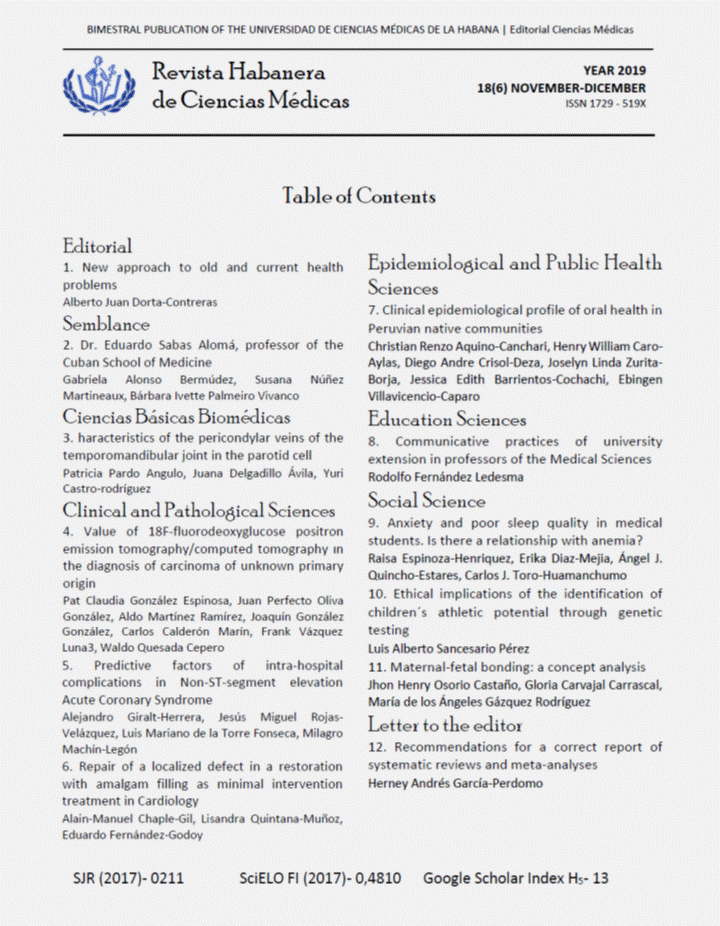Value of 18F-fluorodeoxyglucose positron emission tomography/computed tomography ın the diagnosis of carcinoma of unknown primary origin
Keywords:
Tumor of unknown origin, CUP, PET/CT, F-FDG-PET/CT, metastases from unknown primary tumor.Abstract
Introduction: The incidence of carcinoma of unknown primary origin in oncologic patients is from 0,5 % to 7 % at the time of diagnosis with an overall 3-year and 5-year survival of 11 % and 6 %, respectively.
Objective: To assess the effectiveness of 18 F-FDG-PET/CT (18F-fluorodeoxyglucose posıtron emıssıon tomography) in the diagnosis of carcinoma of unknown primary origin (CUP).
Material and Methods: F-FDG-PET/CT studies were conducted in patients with CUP in the search for primary tumor with negative previous conventional studies carried out from November, 2017 to June 2018. The final diagnosis was established by histological confirmation and/or clinical/radiological follow-up during 8 months.
Results: A total of 44 patients were studied. There were evidences of suggestive CUP in 19 patients; 9 of them were histologically confirmed as true-positive and only 1 was a false-positive. Of the 23 patients with negative F-FDG-PET/CT studies for primary tumor, all of them continued with the diagnosis of CUP in spite of multiples diagnostic tests. Conclusions: The FDG-PET/CT technique allowed to identify 45,2 % of the primary tumors in this study, which demonstrates that it is very useful tool for the diagnosis of metastases of unknown origin. It is considered that F-FDG-PET/CT studies should be included earlier in the diagnostic algorithms in Cuba, which will allow to indicate subsequent complementary tests.Downloads
References
1. Gallegos Hernández JF. Metástasis ganglionares cervicales de carcinoma epidermoide con tumor primario desconocido. Abordaje diagnóstico-terapéutico actual. An Orl Mex [Internet]. 2016 [citado 14 Feb 2019]; 61(1):57-65. Disponible en: http://www.medigraphic.com/cgi-bin/new/resumen.cgi?IDARTICULO=64832
2. Pavlidis N, Briasoulis E, Hainsworth J, Greco FA. Diagnostic and therapeutic management of cancer of an unknown primary. Eur J Cancer [Internet]. 2003 [citado 14 Feb 2019]; 39(14):1990–2005. Disponible en: https://www.sciencedirect.com/science/article/pii/S0959804903005471
3. Piccioli A, Maccauro G, Spinelli MS et al. Metástasis óseas de origen desconocido: epidemiología y principio de manejo. J. Orthop Traumatol. [Internet]. 2015 [citado 14 Feb 2019]; 16(2): 81-6 Disponible en: https://doi.10.1007/s10195-015-0344-0
4. Ettinger DS, Varadhachary GR, Bowles DW et al. Occult primary. Cancer unknown primary. [Internet] Versión 1.2018 [actualizado Oct,2018; citado 5 abr 2019]. National Comprehensive Cancer Network (NCCN) guideline. J Natl Compr Cancer Netw. Disponible en: NCCN.org
5. Lee JR, Kim JS, Roh JL, Lee JH, et al. Detection of occult primary tumors in patients with cervical metastases of unknown primary tumors: comparison of 18F FDG PET/CT with contrast-enhanced CT or CT/MR Imaging-prospective study. Radiology [Internet]. 2015 [citado 28 de Mar 2019]; 274:764-7 Disponible en: https://www.ncbi.nlm.nih.gov/pubmed/25405771
6. Budak E, Yanarates A. Role of 18F-FDG PET/CT in the detection of primary malignancy in patients with bone metastases of onknown origin. Rev Esp Med Nucl Imagen Mol. [Internet]. 2019 [citado 24 de nov 2019]. Disponible en: https://doi.org/10.1016/j.remn.2019.06.002
7. Oliva JP, Martínez A. Aplicaciones del PET/CT en oncología. Revista Nucleus [Internet] 2017; [citado 19 de May 2019] 62:10-13. Disponible en: http://scielo.sld.cu/scielo.php?script=sci_serial&pid=0864-084X&lng=es&nrm=iso
8. R. Sopena, Martínez C. Tumor de origen desconocido. Manual PET-TAC para residentes. En: SIMED SOFTWARE, S.L. - Costa del Sol, 3 - 28033 Madrid. GE healthcare, España; 2017;9:118.
9. C. Olivas Arroyo. Radiofármacos utilizados en la tomografía por emisión de positrones: presente y perspectivas de futuro. Radiología. [Internet] 2016; [citado 19 de May 2019]. 58(6):468-480. Disponible en: https://doi.org/10.1016/j.rx.2016.07.003
10. Sven N. Reske, Jörg Kotzerke. FDG-PET for clinical use. Results of the 3rd German Interdisciplinary Consensus Conference, "Onko-PET III". Eur J Nucl Med. [Internet]. 2001. [citado 26 Jun 2019]; 28(11):1707-23. Disponible en: https://link.springer.com/article/10.1007/s002590100626
11. Di Martino E, Nowak B, Hassan HA et al. Diagnosis and staging of head and neck cancer: a comparison of modern imaging modalities (positron emission tomography, computed tomography, color-coded duplex sonography) with panendoscopìc and histopathologic findings. Arch Otolaryngol Head and Neck. [Internet]. 2000. [citado 19 May 2019]; 126:1457-1461. Disponible en: https://jamanetwork.com/journals/jamaotolaryngology/fullarticle/405572
12. Zhu L., Wang N. 18F-fluorodeoxyglucose positron emission tomography-computed tomography as a diagnostic tool in patients with cervical nodal metastases of unknown primary site: A meta-analysis. Surgical Oncology. [Internet]. 2013. [citado 23 Oct 2019]; 22(3):190–194. https://doi: 10.1016/j.suronc.2013.06.002
13. Umut Elboga, Selim Kervancioğlu et al. Utility of F-18 fluorodeoxyglucose posıtron emıssıon tomography/computed ın carcınoma of unknown primary. Int J Clin Exp Pathol [Internet]. 2014. [citado 19 May 2019]; 7(12):8941-8946. Disponible en: https://www.ncbi.nlm.nih.gov/pmc/articles/PMC4314024/
14. Silva P, Hulse P, Sykes AJ, Carrington B, Julyan PJ, Homer JJ, et al. Should FDG-PET scanning be routinely used for patients with an unknown head and neck squamous primary? J Laryngol Otol. [Internet]. 2007. [citado 6 de Jun 2019]; 121:149–53. Disponible en: https://doi.org/10.1017/S0022215106003781
15. Breuer N, Behrendt FF, Heinzel A, Mottaghy FM, Palmowski M, Verburg FA. Prognostic relevance of 18F-FDG PET/CT in carcinoma of unknown primary. Clin Nucl Med. [Internet]. 2014. [citado 6 de Jun 2019]; 39(2):131-5. Disponible en: https://doi:10.1097/RLU.0000000000000304.
16. Imperiale A, Rust E, Taieb D. 18F-Fluorodihydroxyphenylalanine PET/CT in Patients with Neuroendocrine Tumors of Unknown Origin: Relation to Tumor Origin and Differentiation. Journal of Nuclear Medicine. [Internet]. 2013. [citado 23 de oct 2019]; 55(3):367–372. https://doi:10.2967/jnumed.113.126896
17. Prowse SJ, Shaw R, Ganeshan D, Prowse PM, Hanlon R, Lewis-Jones H, Wieshmann H. The added value of 18F-fluorodeoxyglucose positron emission tomography computed tomography in patients with neck lymph node metastases from an unknown primary malignancy. J Laryngol Otol. [Internet]. 2013. [citado 6 de Jun 2019]; 127(8):780-7. Disponible en: https://www.ncbi.nlm.nih.gov/pubmed/23919968
18. Wang G, Wu Y, Zhang W, Li J, Wu P, Xie C. Clinical value of whole-body F-18 fluorodeoxyglucose positron emission tomography/computed tomography in patients with carcinoma of unknown primary. J Med Imaging Radiat Oncol. [Internet]. 2013. [citado 6 de Jun 2019]; 57(1):65-71. Disponible en: https://www.ncbi.nlm.nih.gov/pubmed/23374557
19. Talabera-Rubio et al. Utilidad de la tomografía por emisión de positrones con 18F-fluorodesoxiglucosatomografía computarizada en la identificación del tumor primario en pacientes con cáncer de origen desconocido. Med Clin (Barc). [Internet]. 2013. [citado 6 de Jun 2019];140(1):14–19. Disponible en: http://dx.doi.org/10.1016/j.medcli.2012.04.033



